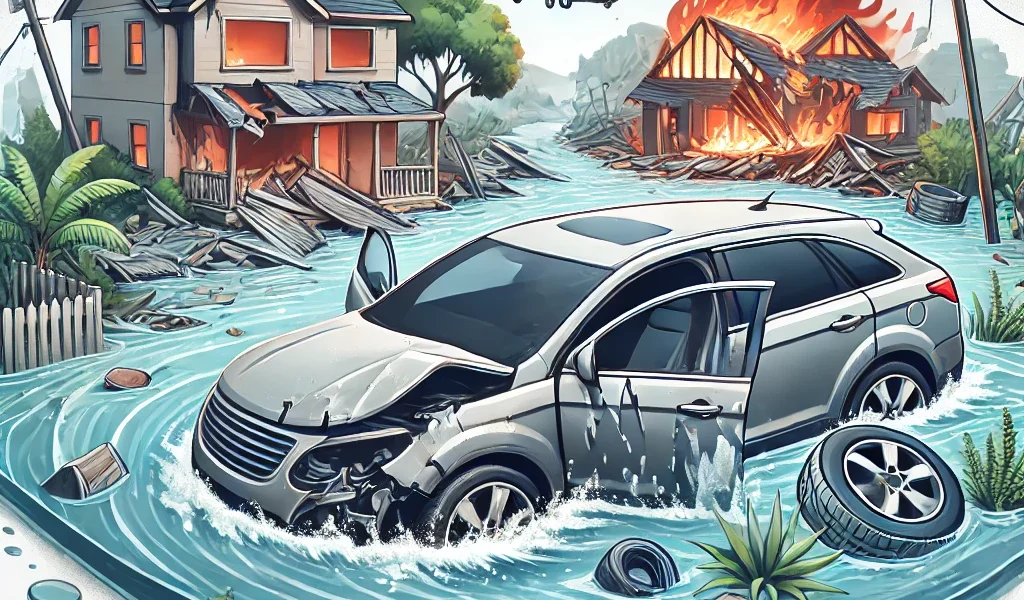Natural disasters such as hurricanes, floods, earthquakes, and wildfires can cause severe damage to vehicles. If your car has been affected by a natural calamity, filing an insurance claim can help you recover financial losses. However, the process can be complex, and any mistakes could lead to claim denials or reduced payouts. This guide will help you navigate the car insurance claim process after a natural disaster, ensuring that you take the right steps and avoid common pitfalls.
Understanding Natural Disaster Coverage in Car Insurance
Not all car insurance policies cover natural disasters. Generally, comprehensive coverage is required to receive compensation for damages caused by:
- Floods and heavy rain
- Hurricanes and tornadoes
- Earthquakes and landslides
- Wildfires and severe storms
- Hail damage
If you only have liability or collision coverage, your policy may not cover these damages. Always check your insurance policy to understand what is covered.
Steps to Take After a Natural Disaster
1. Ensure Safety First
- Before assessing the damage, prioritize your safety and the safety of those around you.
- If your vehicle is in a hazardous location, avoid approaching it until conditions improve.
2. Document the Damage
- Take clear, high-resolution photos and videos of your car from multiple angles.
- Capture the surroundings to show evidence of the disaster’s impact.
- Note the date, time, and location of the incident.
3. Contact Your Insurance Provider
- Notify your insurance company as soon as possible.
- Provide initial details about the damage and the natural disaster that caused it.
- Ask about the next steps and required documentation.
4. Prevent Further Damage
- If safe to do so, take temporary measures to prevent additional damage (e.g., covering broken windows with plastic sheeting).
- Avoid attempting major repairs until an insurance adjuster has inspected your car.
5. File an Insurance Claim
- Submit the required documents, including photos, videos, and a written description of the event.
- Fill out the claim form accurately and provide any additional information requested by your insurer.
6. Cooperate with the Insurance Adjuster
- An insurance adjuster will inspect your vehicle to assess the damage.
- Be honest and provide all necessary details to facilitate the claim process.
7. Review the Settlement Offer
- Once the insurer evaluates the claim, they will provide a settlement offer.
- Carefully review the offer and negotiate if necessary to ensure a fair payout.
Do’s and Don’ts of Filing a Car Insurance Claim After a Natural Disaster
Do’s:
✔️ Review Your Policy: Understand what your insurance covers and any deductibles that apply. ✔️ Act Quickly: Report the claim as soon as possible to avoid delays. ✔️ Keep Records: Maintain a file with claim documents, photos, emails, and conversations with your insurer. ✔️ Be Honest: Provide accurate information about the damage to avoid claim denial. ✔️ Work with Approved Repair Shops: If your insurer has a list of preferred repair shops, consider using them to simplify the claim process.
Don’ts:
❌ Don’t Delay Filing a Claim: Some insurers have time limits for filing claims after a natural disaster. ❌ Don’t Exaggerate Damages: Providing false or inflated claims can lead to denial or legal consequences. ❌ Don’t Discard Evidence: Keep all damaged parts and receipts for repairs for verification. ❌ Don’t Settle Too Quickly: Evaluate the insurer’s offer carefully before accepting.
Common Reasons for Claim Denials
Insurance companies may deny claims for various reasons, including:
- Lack of comprehensive coverage.
- Late claim filing.
- Insufficient documentation.
- Misrepresentation of facts.
- Pre-existing damage not related to the disaster.
To minimize the risk of denial, ensure you follow the correct claim procedures and provide accurate information.
Conclusion
Filing a car insurance claim after a natural disaster can be overwhelming, but taking the right steps can streamline the process. Understanding your coverage, documenting damages, and communicating effectively with your insurer are crucial to securing a fair settlement. By following this DIY guide, you can navigate the claims process smoothly and recover losses efficiently. If you have any doubts, consult your insurance provider for specific guidance related to your policy.




